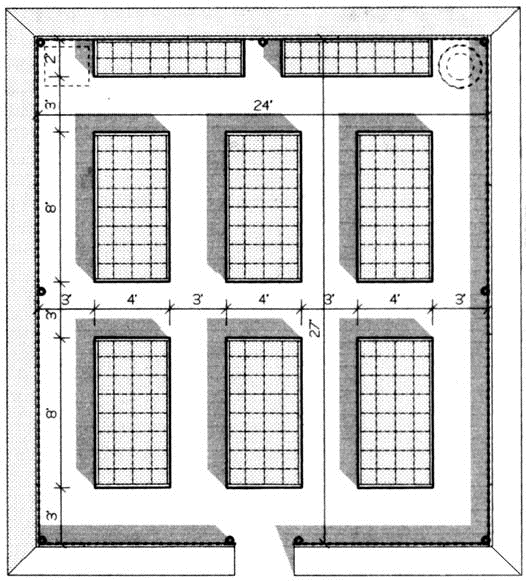by Juan Wilson © 1994 The Gobbler: Winter
Thaw Everybody has a different approach to
building this kind of thing, so let's start with
understanding that nothing is sacred when it comes to
building a raised bed garden. The example I'm going to
share with you is my experience the first time building a
raised bed for an intensive "square foot" garden. There
have been some problems, but it seems to have worked out
fairly well. The material you use to raise the
earth in a raised bed needs careful selection. Wood and
stone are candidates for edge material. But contamination
by chemicals must be considered. Therefore, treated wood
like railroad ties or decking material is out. The tars
and chemicals from these woods are poisonous and easily
leach into the soil. If using brick, even mortar rubble
might be considered a problem. We chose to use fresh cut green lumber
from a nearby Amish sawmill. There are several in the
area, and they are all priced considerably lower than
Grossman's or other commercial lumber yards for the same
volume of wood. We bought 1"x10"x8' lumber for about 1/3
the cost of a commercial yard. We needed 36 boards.
We strongly suggest you lay out your
garden with a scaled drawing. One quarter inch equals a
foot is convenient if all you have is a ruler, pencil and
letter size paper. We were planning "square foot"
gardening, so we wanted earth boxes that could be
flexibly divided in one-foot-square modules. We decided
to use 4 foot by 8 foot boxes. This would require little
cutting of our 8 foot boards and it would be narrow
enough to be accessible. At the north end of the garden
we placed narrower boxes, 2 foot by 8 foot, for the
climbers (tomatoes, beans etc). Once we decided on a
layout we cut the boards and simply laid them out on the
ground where they would be made into boxes. When spacing
the boxes be sure to leave wide enough aisles. We suggest
3 to 4 foot minimum. When positioned, we hammered the
boards together with galvanized nails, and leveled the
boxes a bit. There will be a tendency, once loaded, for
the long sides of the boxes to bulge. This can be
countered by pounding a peg into the ground on either
side of the box, or nailing a strip of wood underneath
and between the two long sides to act as a
strap. We used heavy galvanized tubes seven
feet long for the corners and gate opening of our garden.
Use a post hole digger to get them in. Lightweight, bent
steel garden posts are cheap, but bend a lot and rust
quickly. We used them only between the tubes, where there
was little stress. We hooked two fifty-foot rolls of
galvanized chicken wire to the outside of the poles. When
the wire was in place we edged the outside of the garden
fencing with more 1"x 10"x 8' boards and piled earth
against them. This was to discourage animals from
burrowing under the wire fencing. We then stapled the
chicken wire to the inside of the boards, creating an
earth and wire fortress. Around the outside of the boxes we
used a chainsaw to make quarter inch deep nicks every one
foot on center. This was so that later we could easily
find the square foot modules for garden planning. String
could be stretched between the nicks, or eyeball seeding
and watering could be done, using the nicks as guides.
We filled the planting boxes with a
mix of some earth from the aisle with composted manure,
wood ashes, and lime. For the climbing plants we
constructed a frame cut from similar branched saplings
pounded into the ground. Cross members sit in the crotch
of the branched vertical saplings over each box. String,
for climbers, was tied from the cross members to nails in
the planting box frame below. We had spaces in the north
corners of our garden. In one we placed a work table and
folding chair, and in the other a galvanized welded
garbage can we could fill with a hose (or with rain) for
our ever thirsty watering can. Incidentally, the first
summer we had no invaders into our garden, but last year
something jumped or climbed the wire. We may have to go
with an electric strand, or move our doghouse over to the
garden as a defense.

Home